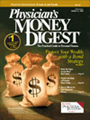Publication
Article
Physician's Money Digest
Read the Signs for the Next Dell Today
Author(s):
Don't you wish you had purchased shares ofDell or Best Buy years ago? Sure, hindsightis 20/20, but how can physician-investorsrecognize which company will be the nextDell? It's easier than you think.
Think of your experiences as a customer. If a badexperience would prompt you to stop shopping at acompany's stores, it's likely you wouldn't want to ownthat company's stock. The opposite is also true.
Fortune
An article in relates an initiative by BestBuy called customer-centricity. Employees at a Best Buylocation piloting the initiative understood not onlytheir customers, but also the relationship betweenincreasing sales within a particular customer segmentand the company's return on invested capital, whichhappens to drive Best Buy's stock price. They wereempowered to make customer-centric changes.
The results:
Best Buy's same-store sales grew 9%during a given quarter, while sales at its seven customer-centric stores in that market grew 30%.Shareholders as well as customers win, because the customer-centric approach results in increased earningsplus a higher price-to-earnings (P/E) multiple that isapplied to those earnings.
The article refers to rerating the P/E, which is criticalto making stocks rise in today's investing environment.It has been the key to Dell's performance as thebest stock over the past decade, and the reason BestBuy's stock has doubled over the past year.The article suggests you can find the next Best Buyor Dell by asking yourself the following key questions:
The results:
• Is a company putting your needs first? Considerthe case of Royal Bank of Canada (RBC), which identified a segment of its customers who spend winters livingin Florida or Arizona. According to the article, these customerswant the same preferential treatment they receiveat home. They want a US credit rating that reflects theirCanadian track record and want to be served by employeeswho can speak French. RBC responded by opening abranch in Hollywood, Fla, and customers signed up indroves. Company stock has grown 18% ayear on average over the past 4 1/2 years.
• Does your company know the difference betweencustomer segments? Best Buy has configured certainstores to better serve its different customer segments,addressing their different wants and needs. Some storesare configured to meet the needs of the group it calls"upper-income soccer moms." Other stores are configuredto address the needs of affluent male entertainmentlovers, budget-conscious family men, and earlyadopters of new technologies.
• Who is responsible for your customer segment?Rather than separating employee responsibilities bydepartments, companies like Dell, RBC, and Best Buyhave individuals who are responsible for specific customersegments across multiple stores. To find outwhere a company stands, the article suggests contactinga part of the business you haven't used before. Forexample, if you have only a checking or savingsaccount with a particular bank, call its mortgagedepartment to see if they know who you are.
• Do employees understand the practice of earninga return on invested capital that exceeds capital cost?They should know how much capital has been investedin a segment and how much return has been earned.Most importantly, employees should understand howtheir actions impact the company's share price. Talkwith them about this.
• Is a company standing pat, or does it continuallytest new customer offers? The article points out thatthe convenience store 7-Eleven in Japan meets withemployees each week to discuss tests and results as theyoccurred. A successful customer-centric company willhave in place a formal process for understanding whatproducts and services customers prioritize.
Does a company you're familiar with answer positivelyto these points? Few do, but if you find one, you mayalso have found yourself a winner.
